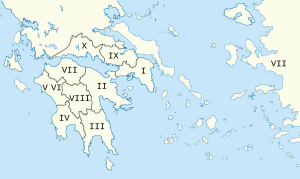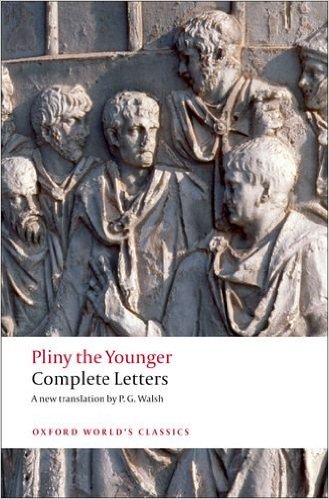
Map based on Description of Greece by Pausanias. The map shows the locations of ancient Greece described by each book in the work, distributed under a CC-BY 4.0 license / Numeral font and territorial border widths modified from the original.
Pausanias must have been an amiable man. He spent at least fourteen years writing a firsthand description of 2nd century Greece that is famous in classicist circles for being the world’s oldest surviving guidebook. He visited many places and evidently spoke with many people about their local customs and traditions. The stories that he compiled from these conversations and other written sources reflect a curious set of interests. The British encyclopedist Hugh Chisholm describes Pausanias as being ‘fascinated by all kinds of quaint and primitive images of the gods, by holy relics and many other sacred and mysterious things’ [1]. He is also fond of digressions on Greek legends and the wonders of nature. The work, Description of Greece, was very nearly lost in the middle ages, and it is only by the skin of our teeth that the manuscript has come down to us at all. There are a number of English translations [2-5]. Of these, Peter Levy’s contemporary translation in two volumes in the most readable [2,3]. The quotations found below are taken from his work. The full text is, however, unavailable online because it remains under copyright. Older translations by James George Frazer [4] and William Henry Samuel Jones [5] are in the public domain. What follows is a compilation of Pausanias’s finest anecdotes.
Book I: Attica
-
Praxiteles’ Masterpiece (1.20.1–1.20.2)
Once when Phryne asked what was his (Praxiteles’) most beautiful work, he promised like a true lover to give it to her but refused to say which he thought it was. So a servant of Phryne’s came rushing in and told him his house was on fire and most of his work was lost. Praxiteles rushed out of the doors exclaiming that if the fire had got at the Satyr and the Eros then he had worked for nothing. Phryne told him he could put his mind at rest, nothing horrible had happened except that he was trapped into admitting which was his masterpiece. So Phryne chose Eros, and Dionysos in the temple close by has had the Satyr boy to offer him a drink; Eros standing beside him and Dionysos are by Thymilos.
-
A Rape on the Satyr Islands (1.23.5–1.23.6)
A Carian called Euphemos said he was sailing to Italy and was driven off course, right out into the open sea, which is still empty. He told me there were a lot of desert islands, and islands where savages lived; the sailors were unwilling to put into these islands, as they knew something about the natives from having called there before, but now they were forced to put in again. The sailors call them the Satyr islands. The natives are very noisy and have tails on the behinds as long as a horses. As soon as they noticed the ship, they ran down at it without saying a word and grabbed at the women. In the end the sailors were so frightened they threw out a barbarian woman onto the island, and she was raped by the satyrs not only in the usual place but all over her body.
- Aristeas of Prokonnesos (1.24.6)
-
The Locust Plagues of Mount Sipylus (1.24.8)
I myself know that locusts have been destroyed three times in the past on Mount Sipylus, and not in the same way. Once a gale arose and swept them away; on another occasion violent heat came on after rain and destroyed them; the third time sudden cold caught them and they died.
- An Axe is Acquitted of Murder at the Prytaneion court (1.28.10)
- Nikokles of Tarentum (1.37.2)
- The Harp-stone Legend (1.42.1–1.42.2)
Book II: Corinth and the Argolid
- Sinis the Robber (2.1.3–2.1.4)
- The Sacred Grove of Asklepios (2.27.1–2.27.3) (see page 218)
- Arriphon the Scholar (2.37.3–2.37.4)
Book III: Laconia
- Theodorus of Samos (3.12.10)
- A Strange Occurrence Involving the Dioscuri (3.16.2–3.16.4)
- Euryleonis (3.17.6)
- The Magic Spring of Tainaron (3.25.8)
Book IV: Messenia
Book V: Elis 1
- The Two Marvels of Elis (5.5.2)
- Callipateira (5.6.7–5.6.8)
- Damarmenus (5.13.4–5.13.4)
- An Egyptian Named Rhantes is Charged the First-ever Misdermeanor (5.21.11–5.21.14)
- Sarapion of Alexandria (5.21.18)
Book VI: Elis 2
- The Tall Tale of Poulydamas (6.5.4–6.5.9)
- Kleomedes the Mass Shoter (6.9.6–6.9.8)
- Glaukos the Novice Boxer (6.10.1–6.10.3)
- Theagenes the Multi-sport Athlete (6.11.2–6.11.9)
- The Feats of Milo (6.14.5–6.14.8)
- The Horse Scarer (6.20.15–6.20.19)
Book VII: Achaia
- Phormion’s Prophetic Dream (7.5.3-7.5.4?)
- A Spooky Demeterian Oracle (7.21.10–7.21.14)
- The Oracle of Hermes (7.22.1–7.22.3)
- Earthquake Classification before the Richter Scale (7.24.4–7.24.7)
Book VIII: Arcadia
- Aristokrates (8.5.11–8.5.13)
- Pelias’s Daughter and the Ram (8.11.2–8.11.3)
- The Tomb of Helen the Jew (8.16.5)
- Herakles and the Man-eating Birds (8.22.4)
- The Children of Kaphyai (8.23.6–8.23.7)
- The Indian Giant (8.29.3–8.29.4)
- The Priest of Lykaian Zeus (8.38.4)
- The Lykaian Zeus (8.38.4–8.38.6)
- Arrachion (8.40.1–8.40.2)
Book IX: Boiotia
Book X: Phocis
- Phalanthos and the Dolphin (10.13.10)
- The Axe of Tenedos (10.14.1–10.14.2)
- Syllias the Diver (10.19.1)
References
[1] Pausanias (Traveler) edited by Chisholm, Hugh (1911), Encyclopædia Britannica (11th ed.). Cambridge University Press. Read this article at studylight.org.
[2] Pausanias Guide to Greece 1: Central Greece translated by Peter Levi (1984), Penguin Classics.
[3] Pausanias Guide to Greece 2: Southern Greece translated by Peter Levi (1984), Penguin Classics.
[4] Pausanias’s Description of Greece translated by James George Frazer (1898), Macmillan. Read this classic translation at The Internet Archive.
[5] Pausanias’s Description of Greece translated by William Henry Samuel Jones and Henry Ardene Ormerod (1918), Harvard University Press. Read this translation at The Perseus Digital Library.

